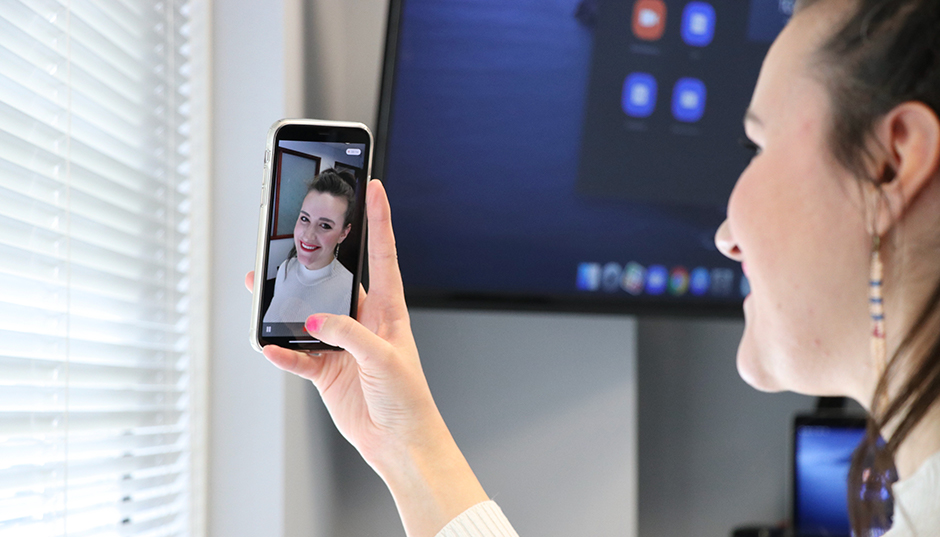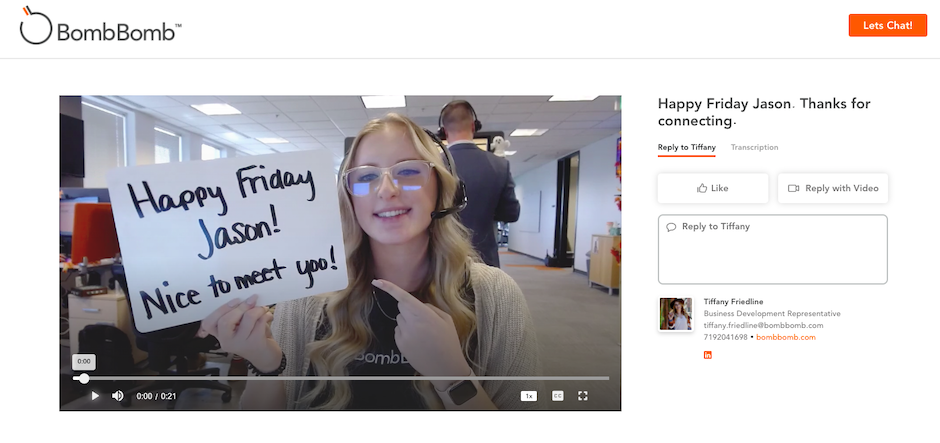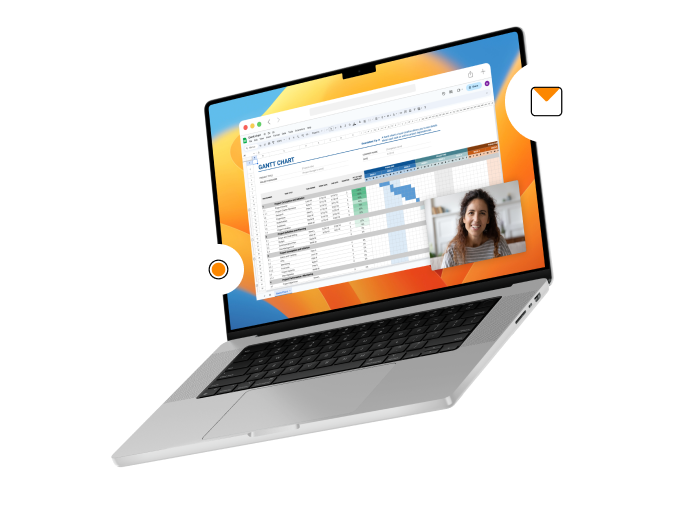You’ve got a promising prospect, and it’s time to make a connection with them. But it can be hard to connect and earn the trust of someone you’ve never met — especially when you aren’t face to face. And if you don’t know how to show empathy in sales, it’ll make it more difficult.
You see, technology has taken over communication. And more often than not, a lack of trust in salespeople is amplified because the world of technology is clouded with digital pollution — spam, bots, and persuasive tech that create mistrust in what or who is behind a screen.

In fact, according to Washington Monthly, the damaging byproducts of digital pollution run deep, and while it’s difficult to pinpoint all of them, several problematic issues stand out. These issues include “increased anxiety and fear, polarization, fragmentation of a shared context, and loss of trust as some of the most apparent impacts of digital pollution.”
So, how can you set yourself apart from digital pollution as a trustworthy salesperson? With empathy. Machines can’t empathize, but real people can. And learning to show empathy in sales will help you overcome digital pollution because empathy builds trust.
What is Empathy?
Oxford defines empathy as our ability to truly understand and share another person’s feelings, emotions, experiences, and pain points.
Showing empathy towards your prospective customers demonstrates that you’re a trustworthy person, that you’re safe, and that you aren’t just a piece of tech trying to take advantage of them.
Why It’s Important to Show Empathy in Sales
Understanding empathy and how it can help combat digital pollution is essential to sales effectiveness. But there are also a few other key reasons why using empathy in sales is a game-changer.
Empathy humanizes the sales experience.
When you learn to understand another person’s feelings and empathize with them, you humanize the sales experience.
Rather than looking at prospects as “just a sale,” having a real understanding of empathy shifts your sales mindset. The buying journey becomes a person-to-person experience. Empathy selling isn’t just making the sale. It’s, “This person has a problem, and I can help them.”
Empathy helps sales efforts.
Using empathy helps sales efforts. In the 2020 Edelman Brand Trust Report, 70% of consumers surveyed stated that brand trust is more important today than ever before. Consumers are more likely to buy something from a brand they trust.
Empathy builds relationships.
Once you’ve earned their trust, your prospective customers will feel like they have a relationship with your brand.
Sales is at the front line of the customer journey. A sales rep doesn’t just close a deal. A sales rep sets the tone for the prospect’s relationship with the whole team, for the entire customer experience, and customer retention over time. Check out this episode of “The Customer Experience Podcast” for a more in-depth look at how customer retention begins in sales.
How to Show Empathy in Sales
Truly understanding another person’s emotions and expressing that understanding is the core of empathy. And there are several ways to show you understand and empathize with your prospective customers.
Below we’ve outlined seven tactful ways for sales professionals to show empathy that will create trust and help you close the deal with your next promising lead.
Take a look!
1. Identify Pain Points and Empathize With Them
Empathizing with another person’s emotions will better equip you to understand their problems. When you connect with a promising prospect, it’s crucial to identify their pain points and express empathy for what they’re feeling.
This shows them that you care about them as individuals. And your empathy demonstrates that, to you, they aren’t just a number — they’re a person with real feelings and problems.
It’s also important to know how to express empathy. Below are some helpful phrases you can use to ensure your prospects know you’re listening to their pain points and genuinely understand them…
• “I just had this same problem.”
• “I understand how you’re feeling.”
• “That sounds really frustrating.”
• “I think I understand. You’re saying…”
• “That must be really tough.”
• “I agree with you.”
• “I really understand. How can I help?”
2. Ask Questions to Help and Understand
Once you’ve connected with a prospect and land that first sales meeting, don’t just dig into your pitch.
Start the conversation by asking genuine and thoughtful questions. Listen to your prospect’s answers. Express your understanding and empathy with their pain points, and then don’t just give advice — ask how you can help.
On an episode of “The Customer Experience Podcast,” Brian Robinson, author of “The Selling Formula,” dives into the why behind the sales questions you should be asking. Brian says, “Instead of focusing on the outcome, focus on the conversation and that person you’re about to speak with.” He continues, “Let’s see if we can really help.”
Asking questions to understand and help your prospects will allow you to figure out what problems they’re facing that you can help with.
3. Find Common Ground
The more you ask the right questions and listen to the answers — the more likely you’ll find common ground with your prospects. But, asking the right questions means doing your research ahead of time.
Use social platforms like LinkedIn to find out what interests or hobbies your prospects have before you reach out to them with a pitch. Things like a favorite coffee or sports team and even pastimes like hiking are usually easy to find.
This allows you to relate to them more, so they’re more likely to open up to you when you’re asking them questions.
4. Be Relatable

You can’t expect people to open up about themselves if you remain a closed book. Of course, you don’t need to divulge your entire life story, but you need to be relatable on a personal level.
Showing vulnerability is the key to being relatable and letting your prospects know you can genuinely empathize with them. It shows you aren’t just putting on an act; this is who you really are.
So, what are some of the best ways that you can show your vulnerability to prospective customers?
• Embrace your imperfections: We all know that real people aren’t perfect. Seeing this will help remind your prospects that you’re human, too.
• Be yourself: People can easily spot an act. Being who you genuinely are will help you develop more meaningful connections. Being yourself will also help others feel comfortable enough to be their authentic selves.
• Own up to your mistakes and genuinely apologize: If you dropped the ball on something or missed the mark completely — say so. Everyone messes up. Acknowledging that you’ve made a mistake will make you more trustworthy.
• Admit when you don’t know something: Not knowing the answer to everything makes you human and admitting it makes you relatable. (Tip: Do your due diligence to find the answer to what it is you don’t know. Once you’ve got it figured out, be sure to follow up.)
5. Keep Prospects Engaged
More often than not, there’s some downtime between setting initial appointments and the appointments themselves. Take this opportunity to keep your prospects engaged by sending them something of value.
This reminds your prospects that you’re still around and readily available to help if they need anything. Here we’ve highlighted some easy ways you can keep your prospective customers engaged throughout the sales process:
• Send information about an idea that helps with a problem they mentioned. (This doesn’t need to involve your product or service.)
• Invite them to attend webinars that provide something of value and showcase your product or service.
• Send video reminders for upcoming appointments, product demos, and webinars. (Be sure to include a call to action to leave the door open for ongoing communication.)
• Include new prospects in video email campaigns.
• Use video to ask a follow-up question about something discussed in a previous conversation.
By doing this, you’re showing prospects that you really listened, that you’re available, and that, above all else, you’re continuously empathizing with their feelings and needs.
6. Use “We”
In sales, words are powerful tools. Make your prospects feel like they aren’t alone on this buying journey and use words like “we” and “us” to create a partnership feeling. This feeling of connection will remind your prospects they aren’t in this experience alone — they have you!
Take a look at the top 14 power words for sales success to see what other words you can use to help create a connection with even your most challenging prospects.
7. Use Video to Create Connection

When you’re communicating with prospective customers — use video! Unlike plain-text email, video helps foster genuine relationships by creating an authentic face-to-face connection with each of your prospects.
Video will set you apart as a real person that your prospects can see, hear, and connect with. If you think about it, the more often you see someone and hear their voice, the more likely you are to feel like you really know them, that you’re connected, and that you have a genuine relationship with them.
In addition, using video to communicate with your prospects means they can hear the warmth in your voice and see the concern in your eyes when you empathize with their pain points and say things like, “I understand how you feel.” Empathy is expressed best by facial expression and tone — things you can’t observe through plain-text email.
Seeing your face and hearing your voice will also remind your prospects that you aren’t spam or some kind of persuasive tech. It shows that you’re a real person, and you’re just like them.
Using video will go a long way to help you create genuine relationships and stand out from any digital pollution. So, when should you use video in sales prospecting to make a connection?
• Outbound sales outreach: Cold outreach efforts, LinkedIn prospecting
• Inbound lead responses: Responses to lead inquiries
• When setting appointments: Appointment outreach
• To remind prospects of appointments: Appointment confirmation before demos or meetings
• For recaps/follow-ups: Follow-up after a demo or meeting
Tip: Always use the Empathy, Value, and Action (EVA) Framework when sending videos to prospective customers. Empathize with your prospects, provide value, and include a clear call to action.
Bonus Tip: Building Relationships
People who feel you’ve invested in them by developing a real relationship are more likely to buy your product and stay loyal to your brand. This is because you’ve taken the time to earn their trust.
To begin creating relationships, use social platforms like LinkedIn to really cultivate meaningful connections with prospects. Build a relationship with them first and offer value before requesting a meeting. Don’t just go straight for the sale.
Tip: Send a video through LinkedIn when you request to connect — this will set you apart. (If you’re not sure how to use video on LinkedIn, check out these ways to use LinkedIn video to get started.)
Take Your Empathy One Step Further!
Now that you understand the importance of empathy and have some concrete ways to use empathy in sales for daily prospecting — let’s take it one step further!
Check out, “Video Prospecting 101: Take your Sales Process to the Next Level,” to learn how using video is a great way to show empathy and gain trust as a real person making the sale in a digital world.





